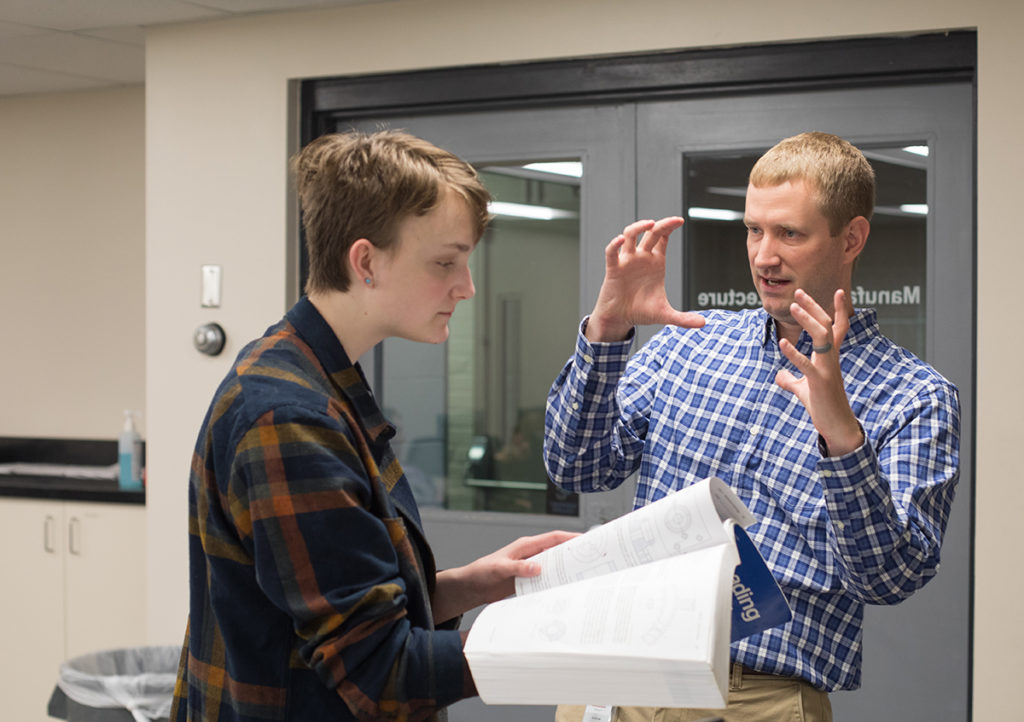Andrew Hoitink’s career as a Mechanical Engineer has included some fascinating projects – ranging from the virtual to the microscopic. As a lab assistant during College he helped build finite element software used for dynamic contact/impact simulations at the Army High Performance Computing Research Center. And as a Research and Development Engineer for Intel, he developed modules for parts smaller than a strand of hair.
But if you had asked him when he first started his studies at the University of Minnesota if he ever thought that he would one day be teaching Mechanical Engineering, the answer would most likely have been no – especially having spent the first three semesters of his undergraduate career in the Physics department.
After a few conversations with a friend who had already been through the Physics program, Hoitink began to rethink the path that he had initially set out on and decided to reroute into the Mechanical Engineering program.
“Mechanical Engineering was the applied version of Physics,” Hoitink recalls.
Looking back, the switch was a natural fit. Growing up, Hoitink had spent a lot of his time taking apart and reassembling different items throughout his parent’s home in Rosemount.
“They knew that sometimes whatever I took apart might not make it back together, but they saw it as a learning opportunity for me and were never really mad about it,” he said.
It was that sort of support and sense of discovery that gave Hoitink a real appreciation for project-based learning, and part of the reason that he continued his studies at the University of Minnesota to complete not only a B.S. in Mechanical Engineering, but his masters and doctorate degrees as well. It was the chance to participate in co-op programs, internships, and the opportunity to work with graduate advisors on projects in the lab that kept Hoitink interested in furthering his education.
On top of all of his studies, one thing that Hoitink said would not change if he had to do it all again would be working as a teaching assistant all throughout graduate school.
“The amount of stuff you learn from teaching others is invaluable,” he said. “You learn 10 times more about that material than you would have studying it on your own. The pressure to know the material really well is really different. It forces you to look at questions from a different angle than you might naturally approach it.”

After a chance meeting with a representative from Intel at a school career fair, Hoitink found himself interviewing for a summer internship in Portland to work on simulations for them. He landed the internship, and a year before completing his doctorate, he interviewed for and accepted a full-time position in Arizona. He was hired as a Research and Development Engineer and worked with a group doing accelerated testing for CPU’s as well as development for next generation parts.
Hoitink enjoyed being a part of huge company that focused on making such small, powerful objects.
“You were forced to be multi-disciplinary and your job was to solve problems,” he said.
Hoitink would continue solving problems for Intel for eight years, four years in Arizona and the rest in Portland.
Portland would bring a change of scenery and a chance to work in a different capacity within Intel within a pathfinding group in module development with a focus on making things faster, smaller, and more economical.
But Minnesota has always been home, and Hoitink and his family recently made the trek back to the Twin Cities – which has possibly brought upon the biggest change of scenery yet. A spot back in the classroom.
Hoitink jumped on board this fall at Dunwoody as a Senior Instructor of Mechanical Engineering. With extensive experience in the industry and a deep appreciation for the power and impact that a hands-on learning experience can have, he is excited to be stepping into this new program that is still moldable.
Having had a hand in a lot of interviewing at Intel for incoming hires, Hoitink saw first-hand that just because someone might have a Ph.D. behind their name doesn’t mean that they know how to do everything. At one point he joked that he thought about bringing in a toolbox and some old equipment during interviews to see what those potential hires would do.
As for the students here at Dunwoody, he is excited about their potential and their promise as they develop the skills they need for their future careers and he fully appreciates the opportunity he has been given to help them along the way.
